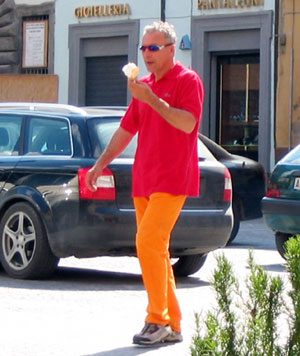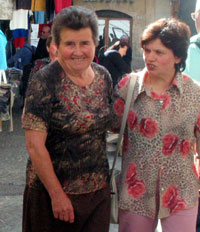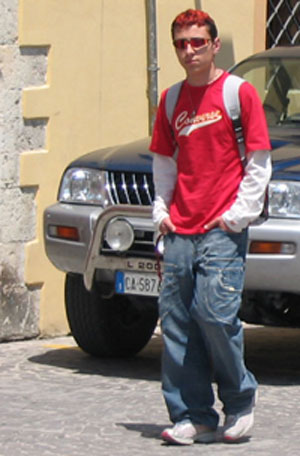 |
|
Though Cagli lags behind major fashion centers, local observers
say the youth of Cagli have become considerably more fashion-conscious
over the past few years, and their taste for fashion continues
to evolve.
“Sometimes it can take up to a year for fashion
trends of bigger cities to reach Cagli,” said Ilaria
Casavecchia, an employee at Rosalba Abbiglismento.
However, according to Alexia Bartolucci owner of Tam Tam,
a trendy shop specializing in young men’s and women’s
clothing, fashion in Cagli is becoming increasingly edgy.
The men and women of Cagli “tend to stay stylish
and comfortable but are becoming more aggressive and are
starting to take more risks” with their clothing,
said Bartolucci.
On Cagli’s cobblestone streets women can be seen
wearing mini-skirts and thin spike heels, often three and
a half inches high. This more edgy fashion is also reflected
in the hairstyles. The women of Cagli can be seen with
layered, darkly streaked blonde hair, rather than more
traditional one-color, single-length bobs.
Both men and women can be seen sauntering around the piazza,
any time of the day, sporting fashionable attire. “It
is difficult to find Italian people who are not well dressed,” said
Bartolucci.
|
|
 |
|
|
A typical outfit for a young Cagliese woman might be a
pair of tinted Chanel sunglasses; pointy white pumps; a
pair of tight denim pants; a fitted, stretch-fabric jacket;
and a neon, jersey tank. Many women wear belts and leather
bags that match their shoes. For the men, a typical outfit
might be a pair of large Christian Dior sunglasses, a form-fitting
Gas T-shirt, crisp blue Diesel denim jeans, and Puma sneakers.
Although Cagli is becoming trendier, young fashion-conscious
Calgiesi might choose to shop outside the town, Bartolucci
said. Many men and women purchase clothing in neighboring
towns like Fano and Urbino because they offer more selection.
In Cagli, residents also shop at the Wednesday open market
as well as stores like Tam Tam and Rosalba Abbiglismento.
The primary customers for these stores vary, but according
to Alexia at Tam Tam, the target age is usually 30 years
or under. Bartolucci said that she usually only changes
her stock seasonally, but that she will also accept special
orders for customers who want something that her store
does not carry.
Alexia finds that television is a big fashion influence
on Cagli residents. Their clothing often imitates what
pop singers, actors and actresses wear, as well as what
fashion magazines show. Young Cagli residents tend to be
inspired by other countries rather than the United States.
|
 |
 |
Cagli has not always been so fashion-conscious.
“I’ve even noticed a significant difference
between the way [Cagliesi men and women] dressed
last summer and the way they dress now,” said
Maggie Bresonis, a Loyola College graduate who
studied last summer in Cagli. “You might
have seen the women in simple linen pants, a fitted
jacket and a scarf; now it seems like the piazza
is a runway and everyone is modeling the latest
trends.”
The older generation is having a tough time adjusting
to the new look.
“It is difficult for them to accept the
way they [the youth of Cagli] dress now,” said
Casavecchia. “They didn’t go around
wearing tight mini-skirts.”
Older women frequently wear dark-colored, long-sleeved
blouses and sweaters, even in midsummer. They regularly
wear knee-length skirts with nude stockings and
dark leather shoes with small, square heels. They
might wear a silk scarf holding back their hair
or tied around their neck. The men often wear button
down-shirts, dark pants and a hat for shade from
the sun.
|
 |
 |
“For Italians, fashion is not just about
clothing and appearance; it becomes a part of their
self-presentation,” said Luciana Guerriero,
a professor of communication at Loyola College
in Maryland and a first-generation Italian-American.
As Bartolucci said, “For Italian people,
the most important things are food, clothing and
the enjoyment of life.”
|
|
| |
|
|


